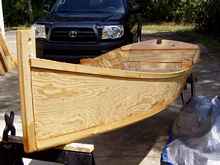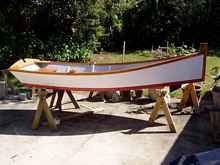| This past June I lost a friend named
Frank Browne. He was sixty-six years old and his passing was totally
unexpected. He was fishing and had caught two nice fish, sat down
and was gone. Frank was a Redemptorist Priest and a fly fisherman
from New York State. Six years ago he was assigned to be pastor
of sacred heart church in new Smyrna beach, Florida. He was a
wonderful Irishman with a twinkle in his eye and a story on his
lips. His time off was usually one morning in mid-week and folks
waited to have him join them fishing off shore or on the mosquito
lagoon. Frank was known to have turned down work as a fishing
guide. He was a priest for forty one years but I wanted to build
a fishing skiff and name it for Fr. Browne, the fisherman.
 |
 |
In June there were two articles on the forest and stream skiff
in Duckworks, one article was a set of free
plans drawn by a fellow in Russia, Sergey Sinelnikov,
and the other was a beautiful build of the skiff. Gavin Atkin
uses the forest
and stream skiff as the heading for his column,
Free Boat Design Resources. This boat had
to become the Fr. Browne fishing skiff.
I used my normal build of small boats. I make the sides, bend
them around a center mold, attach the bow and stern, add external
chines and then glue on the bottom. Checking with the late Phil
Bolger, I was informed that an outside chine added to ability
of small row boats to make way. I’m not sure what Phil meant
but it worked for me. I collected three different sets of plans
for the forest and stream skiff and worked from them but made
adjustments as the boat evolved.
 |
 |
First, a trip to home depot for some plywood. I wanted this
to be bigger then my usual Luan forty pound boats so I went with
¼ inch ply on the sides and ½ inch ply on the bottom
and transom. I ripped a one foot side off of the ¼ inch
ply and measuring 51 ½ inches from each end cut the angle
for my transom. I took 2 feet off the remaining ply making it
3 by 6. From this piece came the bow sections of the sides. At
the bow the height is 18 inches with a 2 inch set back from top
to bottom. The top is a gentle curve to 12 inches where the sides
pieces are connected with a 10 inch square butt block from the
¼ section removed earlier. The center mold is 33 inches
at the bottom and 43 inches at the top, the sides are 12 inches
high. The stem is a 24 inch section of two by four with a rabbet
cut in both sides. I used 15 degrees cuts on a table saw. The
transom is 29 inches at the bottom and 39 inches at the top and
14 inches on the side to allow for the rake. I capped the transom
with a two by six rabbeted to join the transom, then curved the
top with a notch for a sculling oar. I cut the outside chines
at 15 degrees off a 12 foot two by four and also the gunnels.
I used Titebond 3, PL Premium, and fiberglass resin for adhesives.
I caulked with PL concrete seal.
 |
 |
I had trouble bending the gunnels. If I build this again I would
use 17 inches at bow down to 13 inches at the stern but this is
a beauty of a curve along the sheer. I love the look of this little
boat as Gavin Atkin “says it looks salty”.
I added seats, some blocks to fit the nylon bushings and clamp
on oarlocks from Duckworks. I made a heavy-duty breast hook and
quarter knees from a 2x6 and I was good to go.
I copied a boat
trolley again from a Duckworks project to handle
the weight which I estimate to be about 125 pounds. Some simple
seven foot oars completed the project. Here are two oar plans:
Here and here.
The Fr. Browne skiff floats on her lines, tracks well, and rows
easy. She won’t win a race but she is stable and fine for
fishing. Best of all this is a fine looking boat that draws too
much attention. Frank Browne is smiling down.
Free Plans for Gavin Atkins Forest and Steam Skiff here.

|

